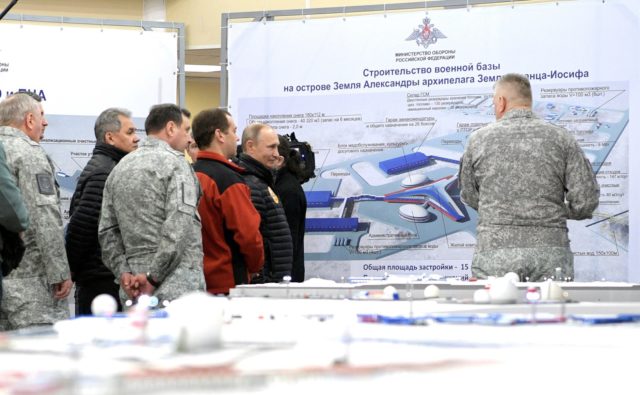
Russia Continues Its Arctic Buildup as Kremlin Perceives a Non-Existent Threat
Publication: Eurasia Daily Monitor Volume: 15 Issue: 11
By:

A great deal of recent commentary has alerted Western audiences to the threat posed by Russian spy ships and submarines in the North Atlantic. These vessels are conducting reconnaissance of United States naval bases and particularly of the trans-oceanic cables that bind together the US with Europe (see EDM, January 23). Those ships and submarines, more often than not, originate from the Russian Arctic and sail toward the North Atlantic. In the event of a hot war, they could be expected to deploy early, probably in advance of hostilities, to locations from which they could interdict Western communications and force deployments. These military and intelligence probes attest to the continuing salience of the Arctic in Russian military thinking. And recent statements by top Russian officials furnish ample proof of the country’s ongoing military buildup there.
President Vladimir Putin alluded to this buildup in his end-of-year review of the Russian military, held on December 22. Specifically, he mentioned six large-scale inspections of 2017 designed to improve the Russian Armed Forces’ ability to rapidly strengthen their units in the Arctic (the numerous snap and regular exercises also carried out last year were not addressed). Moreover, Putin indicated that Vostok (“East”) 2018, the major exercise for this year, would rehearse the transfer of a large-scale group—its personnel, ground hardware and aviation—over huge distances and practice deploying those forces to new areas (Kremlin.ru, December 22, 2017). Clearly, such a scenario could involve deployments to and from the Arctic, which would not be confined to ground forces.
At his annual December “press conference,” held a week earlier, the Russian president highlighted the importance of industrial development, protecting the environment and building up military security—but with no mention of how to reconcile these sometimes contradictory priorities (Kremlin.ru, December 14, 2017). Nor is it by any means clear if the supporting infrastructure to realize Putin’s objectives is being built or even can be.
But that has not deterred the Russian military. At the above-mentioned end-of-year session, where Putin lauded 2017’s Arctic buildup successes, Defense Minister Sergei Shoigu filled in some of the details that speak to the extent of Russian’s activities in the High North last year. In particular, Shoigu lauded the completion of three new “Arctic Shamrock” (three-wing buildings) integrated military facilities there. These include the construction of a fully functioning airfield on the Franz Josef Archipelago, which is open round the clock (Rossiyskaya Gazeta, December 22, 2017). The infrastructure expansion is likely to continue into 2018, if not beyond.
Meanwhile, the Russian propaganda outlet Sputnik News has claimed Moscow is constructing new laser-armed and nuclear-powered “combat” icebreakers (Sputniknews.com, July 17, 2017). This, combined with other reports of Russia boosting its anti-aircraft and Northern Fleet capabilities in the High North (see EDM, September 21, 2015; November 6, 2015; August 1, 2016; May 25, 2017), is already generating Western pressures for compensatory buildups. The US Coast Guard, in particular, is advocating for a much higher budget and greater firepower to rival Russia’s apparent growing naval presence in the Arctic (The National Interest, July 21, 2017).
In other words, Russia is generating an arms race in this foreboding northern region. And it is doing so even as it is clear that nobody in North Atlantic Treaty Organization (NATO) has ever seriously contemplated the implications of Arctic military scenarios or seizing Russian vital natural resources located in the High North. Indeed, the Arctic military threat is a phantasm of the perfervid imagination of Russia’s threat assessors, who invariably gravitate psychologically and materially (because it is in their professional interest to do so) to worst-case scenarios that then drive policy, procurement and the acquisition of resources for their offices (see EDM, March 28, 2014; November 6, 2015; November 16, 2017). This threat inflation and the ensuing diversion of billions in resources to military projects in inhospitable areas like the Arctic (see EDM, August 11, 2015) inevitably come at the expense of Russia’s civilian infrastructure, technology, and human capital as well as the health and education of the Russian people. And, as happened under Communism, it is all too likely that when the end comes for the Putin regime, there will be nothing to show for it except unusable and incomplete infrastructure, suitable primarily if not exclusively for military purposes.
This kind of disproportionate threat assessment and distortion pervaded Putin’s briefing on December 22, illustrating that it will take more than dialogue to put an end to the “new cold war” between Russia and the West. Ultimately, putting an end to the manufactured paranoia of Russian politics and such inflated and self-serving threat assessments may require a change in the regime itself. And that can only be accomplished from within and over a long time.



